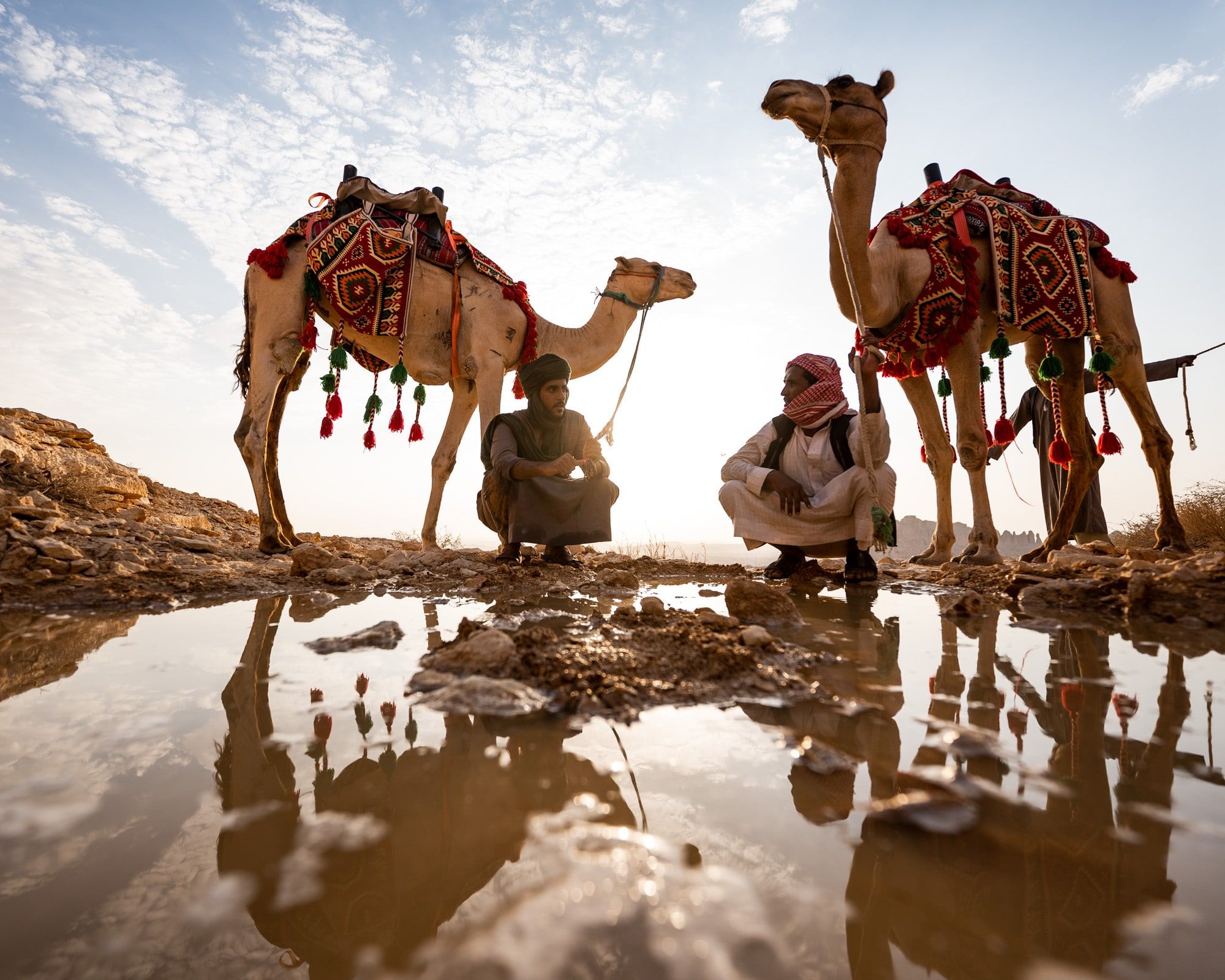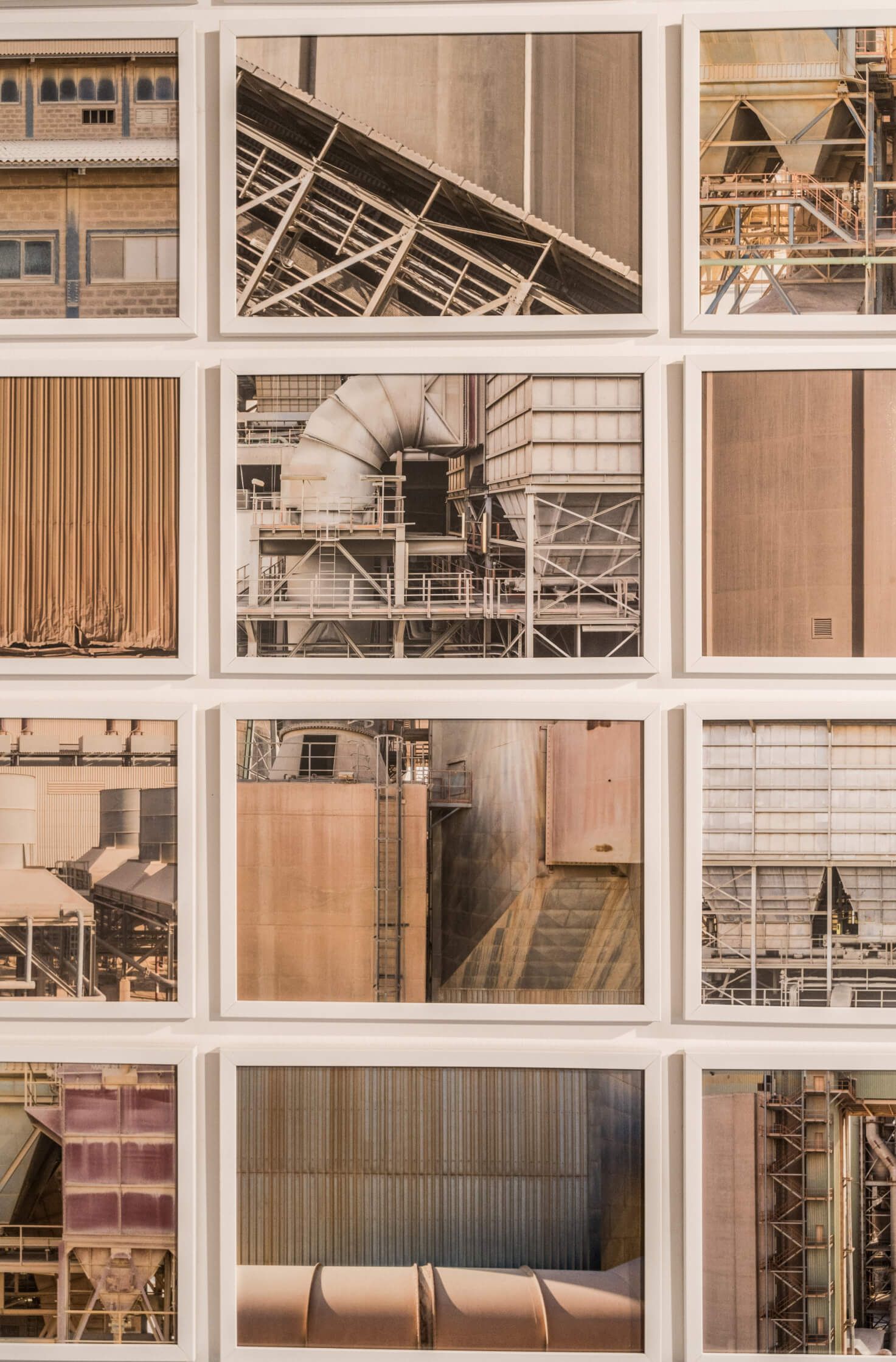The Sound of Sculpting
‘Door of Water’ by Tatsumi Sakai, Tuwaiq Sculpture 2023, Exhibition at Durrat AlRiyadh. Courtesy of Riyadh Art.
Riyadh, with its sandstone hills, is the home of the annual Tuwaiq Sculpture Symposium. Its 4th edition took place in Durrat Al Riyadh from January 8 to February 10, and it featured 30 artists from 20 countries who produced large-scale sculptures that will become permanent fixtures of Riyadh’s urban landscape as public art.
This year’s theme, ‘Energy of Harmony’, developed by the symposium’s curator Marek Wolynski, reflects the balance we all strive for in our lives, as well as ideas of cohesion and mutual understanding in the midst of great transformative change. Artists responded to the theme with concepts existing in their practice and drew inspiration from their physical location in Riyadh, resulting in sculptures that spoke to the local environment while channeling a narrative that transcends borders.
Many of the participating artists are female sculptors carving a pathway for women in the region to enter a largely male-dominated sculpture field.
Included are interviews with four Saudi women sculptors that participated in this year’s symposium.
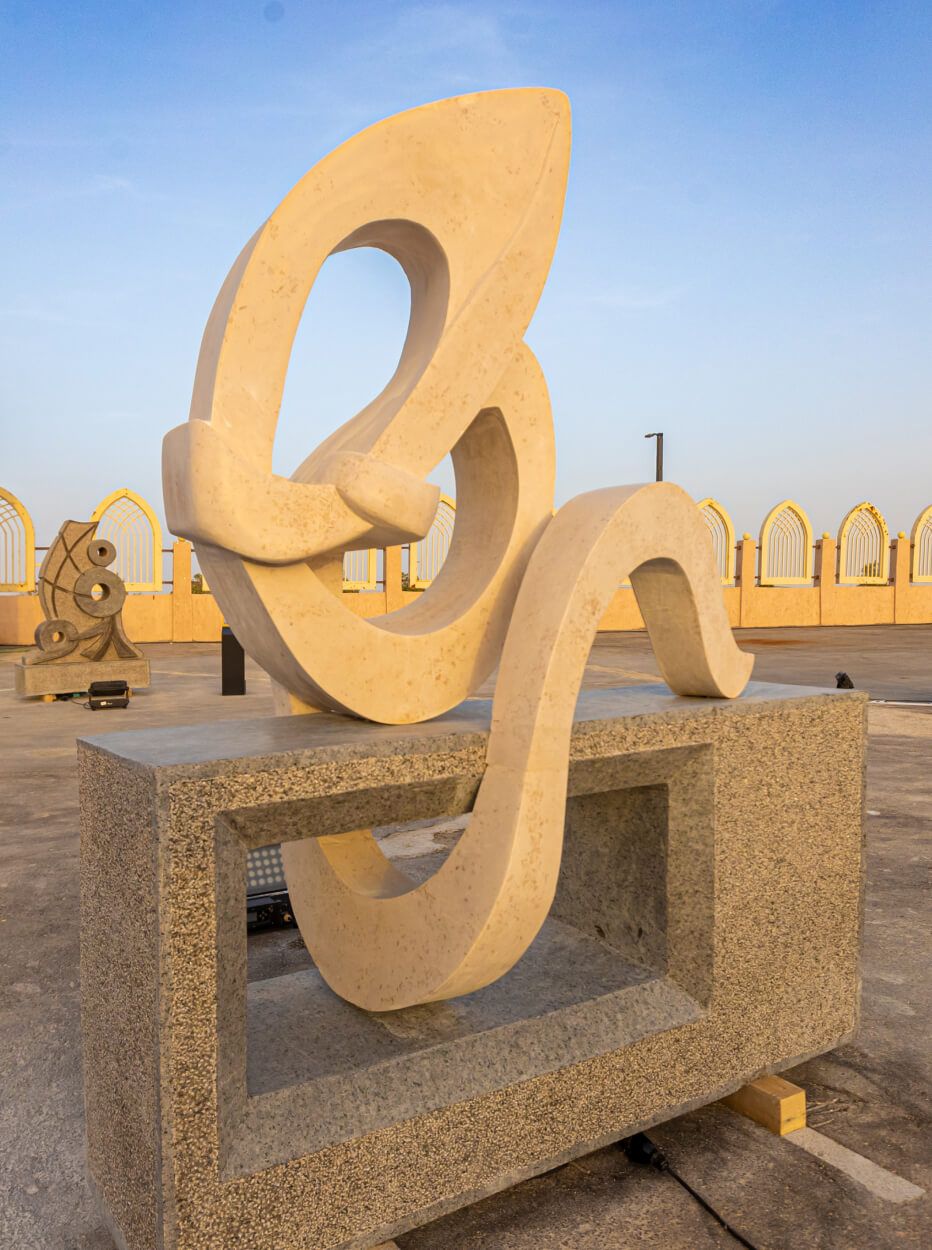
Rajaa Alshafae, Let's Blossom Together, 2023. Courtesy Riyadh Art and Tuwaiq Sculpture 2023.
Q1. This is your second time to join the Tuwaiq Sculpture symposium. Can you tell us your story with sculpture and how you started?
I think my story with sculpture began with the beginning of my practice of plastic art. When I started drawing some ideas and subjects that did not translate well on canvas, I then realized that some of them are better expressed in sculpture and not in drawing. This is what crystallized the idea in my mind later that the concept is what determines the medium. In 2007 when I joined a simplified course for carving, using only a hammer and a chisel, I started participating in exhibitions. I stopped around 2011, and the hiatus lasted until I returned almost five years ago, after learning how to carve marble with electrical tools. This effort bore fruit, and I was chosen to participate in the Tuwaiq Sculpture Symposium, in its third edition in 2021, and this year, the fourth edition, 2023.
Q2.How does your experience in Tuwaiq Sculpture Symposium fourth edition, 2023 differ from your experience in its third edition in 2021?
Each sculptural experience that we go through carries a different cultural and artistic knowledge that is different than the previous one, due to the different participants and their artistic and cultural backgrounds. It also bears new challenges, the biggest for me this year were working on granite stone and the volatile weather conditions.
Q3. Can you share with us an anecdote from the symposium?
One of the funny things about this symposium was meeting some sculptors whom I admire, love their work and follow on social media. I was planning at some point to contact them to ask some questions regarding their sculptures and the techniques they used, but I was hesitant, I wasn’t sure if they would reply. Then the names of the participants in this symposium were announced, and it was a wonderful surprise that we all were participating together. The questions were asked and the mission was accomplished, and we became friends.
Q4. ‘Let's Blossom Together’ combines a hard dark rectangle and a soft light ribbon-like element that wraps around it and goes through it. These two opposite elements come together in great harmony. Can you tell us more about the narrative behind the artwork and how it responds to the curatorial theme: ‘Energy of Harmony’?
I dove into human relationships with this work. Let's Blossom Together considers partnership between two individuals, and the recognition of each other as a complete entity with his and her own rights, dreams, and ambitions. Let's Blossom Together takes these aspects into account as a way to think about balance and beautiful harmony within emotional relationships whose roots extend deep to grow and blossom in every direction.
Q5. I admire how you have transformed an immovable material and made it appear as delicate as a ribbon. How difficult was that to do?
Those two opposing aspects have a continuous harmony in my work, as well as reflecting the philosophy of the piece and enriching the composition of the sculpture. Creating the illusion of softness using such a hard material was a pleasure for me, and not so much an obstacle. Using both stones that were offered each with its own characteristics helped in creating this contrasting illusion. I wanted to invite the viewer to experience the freedom in imagination and creativity.
Q1. This cross-cultural collaboration sits at the heart of symposiums as a meeting point and melting pot for new ideas that transcend borders and boundaries. How was your experience in the Tuwaiq Sculpture Symposium?
In this symposium we were one family. We spent a lot of time together, sharing meals, sitting together and talking. I learned a lot from the 22 artists that came from different countries; talking to them alone was inspiring. To produce work in this size it has to go through several stages. It was nice to see and learn these stages of each artist. Also, each artist approached the curatorial theme differently, depending on where they came from and their professional backgrounds, so each one sculpted in a different way and each one had a specific idea. I am very fortunate that I was one of the eight Saudis that were chosen to be part of this enriching experience.
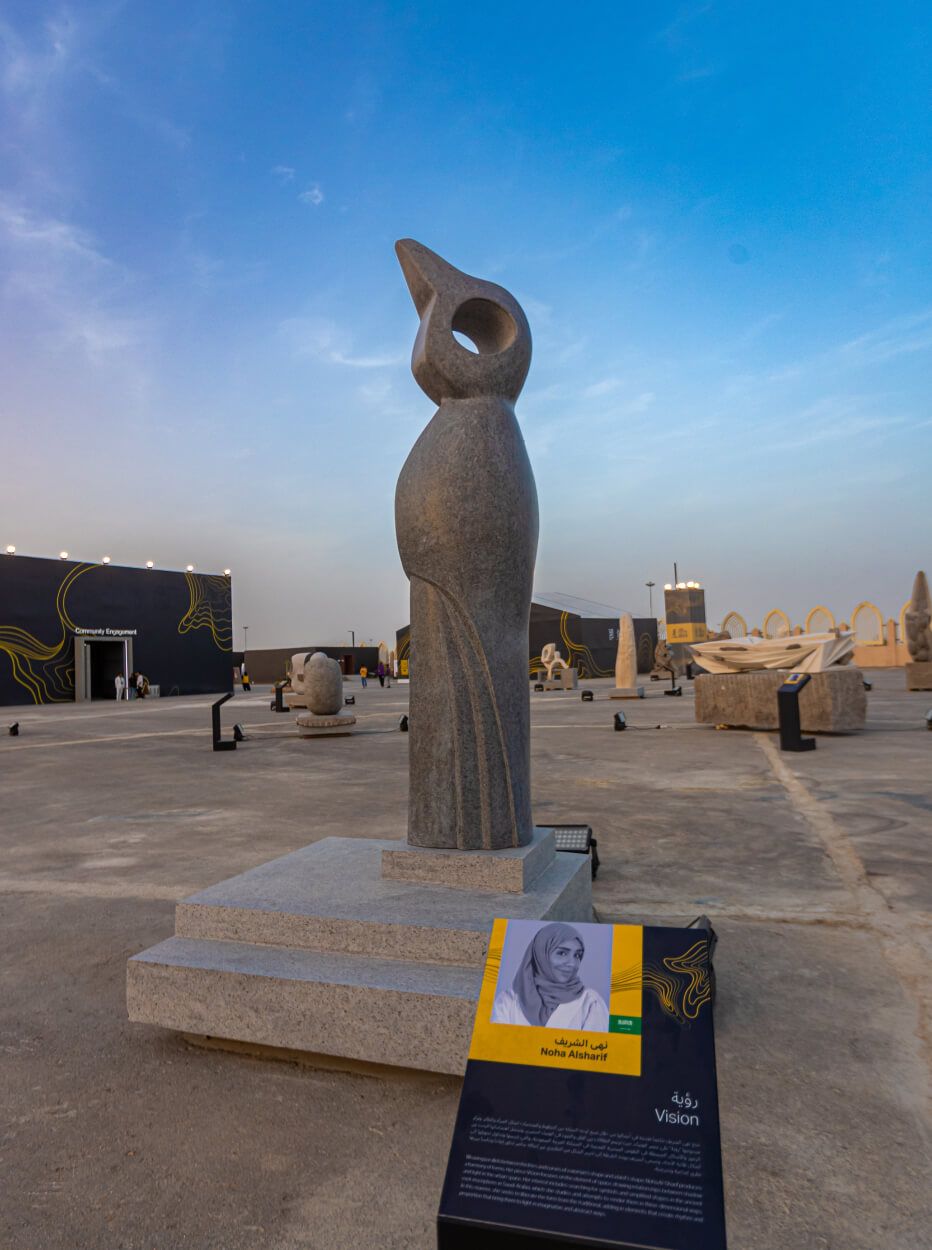
Noha Alsharif, Vision, 2023. Courtesy Riyadh Art and Tuwaiq Sculpture 2023.
Q2. The sculptural piece that you created for this symposium, Vision, combines many elements and stands gracefully and strong. Can you share with us the concept behind your work?
I aimed to weave parallels between the lines and curves of a woman's shape and a bird's shape, to produce a harmony of forms. In Vision I focused on the element of space, drawing relationships between shadow and light in the urban space. I am interested in searching for symbols and simplified shapes in the ancient rock inscriptions in Saudi Arabia, which I have been studying heavily recently, and attempt to render them in three-dimensional ways. I aim to liberate the form from the traditional, adding in elements that create rhythm and proportion that bring them to light in imaginative and abstract ways. This year’s theme, ‘Energy of Harmony’, encouraged me to create sculptures that capture the transformative change that we are currently living through.
Q3.How does this experience differ from your previous work, the “Humbly and Devout” series?
Regarding my previous series of works, I create work that is rooted in the spiritual, paying close respect to the sensibilities of religion and turning representation into abstract figures. While they have that in common, each work I have created is completely different. There are different challenges regarding the materials, the emotional side and the expressive side. My work in Tuwaiq has different symbolism. The bird head represents the old civilizations in the Kingdom, while the eye reflects the vision and looking forward to the future. It implies not just the past but also the present and a vision of the future too. The sculpture reflects peace and glory; with a woman's body standing tall and proud, you can see the carvings in the bottom part which was to convey the folds of fabric in a traditional women's dress. For my new projects I have been researching ancient sculpture and carvings in Saudi Arabia and draw inspiration from it for modern contemporary works.
Q4.Can you explain a little more about your interest in the connection between people and place?
Sculpting in a public space is more than just creating; it is an interaction with the public, the local people, to allow them to share their thoughts and comments with the sculptors. The symposium
was a valuable experience that differs from working privately. During the symposium, people loved to talk to me about art and culture and were very open to sharing their thoughts on global ideas. Participating in the symposium was an adventure. It was great to get to know some of the artists personally and to form friendships. We can be ambassadors of our cultures and mediators to make these cultural exchanges possible with the public.
Q1. How does your experience in Tuwaiq Sculpture Symposium fourth edition, 2023, differ from your experience in its third edition in 2021?
This year it was my first time to sculpt granite and not marble. Granite is the hardest to form in sculpture and generally presents some challenges to the artist, but I actually loved it. It has a lot of different colors in it: red flecks, gray, white and orange. Also, last year my piece was 2 meters and after I was done with it I felt it was small, so this year I went bigger. A comment I heard last year affected me. Because I am a woman and a Saudi, they were impressed and surprised that the curve I have carved was professional, and it was not what they expected. This year, I challenged myself once again to make a new curve. Success is easy to achieve, but maintaining it is difficult. I am very proud that I was able to succeed again.

Wafa Al-Qunibit, Harmony, 2023. Courtesy Riyadh Art and Tuwaiq Sculpture 2023.
Q2. How is Tuwaiq symposium a platform for meeting and collaboration between local and international artists ?
Sculptors came from 20 countries as far as Austria, China, France, Japan, and some otherEuropean countries, as well as strong local representation. This diversity allowed for rich cultural exchange and uniting international and local minds through sculpture. I am a strong believer in the power of art as a tool to bridge cultures. We had enriching cultural dialogues, knowledge exchange of technical abilities and personal energies, in addition to the camaraderie that emerged between us sculptors.
Q3. In the symposium, artists created large-scale public artworks in a live setting. How did this open format of the symposium allow the public to engage with the artists?
The public was allowed to attend and watch the progress of work over the 26 days, and see for themselves how the stone is transformed with skill and artistic dedication. In addition there were the educational visits by universities, where sculpture students had the chance to see the artists in action and help them, which provided them with direct exposure to various sculptural practices, as well as sculpting skills, tools, techniques, and materials.
Q4. In your sculpture, “In Harmony”, what is the feeling you are trying to convey?
I believe that in mass there is silence, in voidness a sound, and in emptiness there is a harmony. Those undulating dips and rises in silent rock are music you hear from every direction with a different type of harmony among people. The softness of the Arabic letter ripples within the solidity and strength of granite so that when hardness and harshness are in harmony, it is like the granite with iron; you hear chants that make the ears sing to fill the place.
Q5. What are the aspects you focused on the most in your sculpture?
In my work I focus on preserving the Arabic letter, and the 99 names of Allah is a series that I have been working on. My aim was to have the work take shape from the name of God it represents. As you see in this work the sculpture has the lines that could be found in an ear to reflect the name Al Sameea.
Q6. Sarah Al-Ruwayti, Tuwaiq Sculpture Symposium manager, said regarding future symposiums that she would love to give artists more freedom to incorporate other materials into their creations. If you were given the freedom to add something to your stone sculpture, what would it be?
I love mixed media, especially with natural materials. Our country is rich in minerals, especially copper, and I am an expert in metal casting and metal laying with small stone sculptures. With large sculptures it is very difficult; it needs extreme precision. During the Misk art symposium my sculpture was mixed media, and I look forward to experiment more with that.
Q1. Would you like to share with us your artistic journey in sculpting?
My experience in the world of sculpture started as a painter. As an artist it was easy to move from one medium to another, so I moved to ceramics, and then to sculpture. Artists have a great passion for experimentation. We like to try all materials before settling on what suits us and what we are comfortable using. Artists have an endless search process, so I tried to search for myself and found it in sculpture.
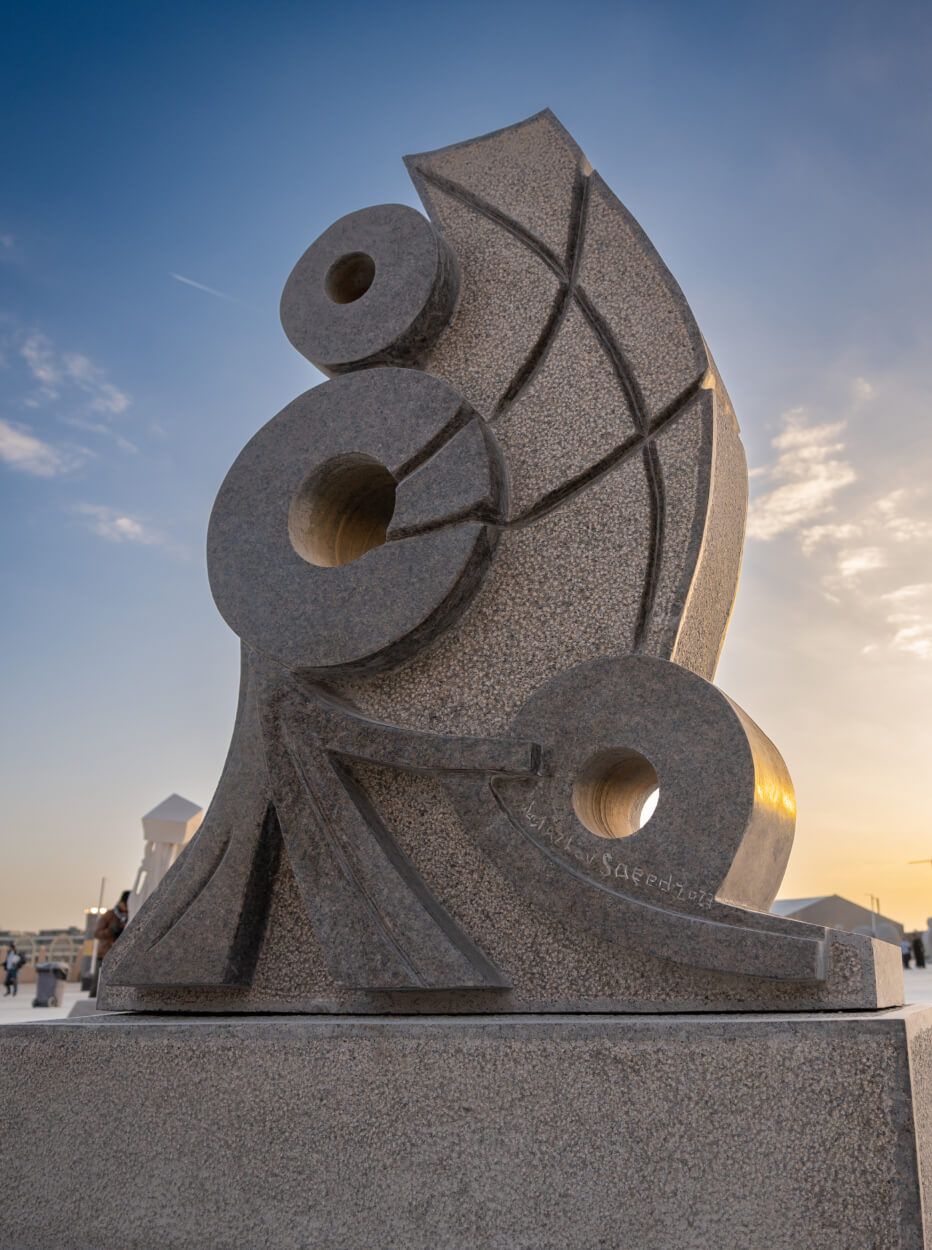
‘Permanence’ by Azhar Saeed, Tuwaiq Sculpture 2023, Exhibition at Durrat AlRiyadh. Courtesy of Riyadh Art.
My beginning was in the Al-Khobar Symposium, and this was the biggest challenge, as I was the only woman among nine sculptors from the Kingdom. There was some criticism regarding my participation. In my opinion, some men were afraid that women would sweep the sculptural arena just as they swept the plastic art arena.
I am proud of the first symposium, because it was my first launch. I have paved the way for women sculptors. There were many good female sculptors in Saudi Arabia then, but I was the first woman to participate in a sculptural symposium in the Kingdom.
Q2. How was your experience in the Tuwaiq Sculpture Symposium?
It was nice to be able to meet and work side by side with sculptors from around the world and learn from their experiences, their ideas, their aspirations, and see what they aim for, and how they get there. My experience in Tuwaiq was very nice. I have gained new experiences and learned new things in terms of design and technology.
Each type of stone has its own method and technique, and this was my first time working with granite. It was challenging, but I loved it and I expect I will always use it. It is full of color and its general color is very dark, which makes it very rich. After finishing my work I looked back at it proudly. I accomplished something beautiful that can enter people's hearts, and they can respond to it.
Q3. What is the inspiration behind your sculpture “Permanence”?
The title Permanence is inspired by the circle, the pulse of human existence, as it refers to nature and the Earth. The circle refers to the cultures of art and construction, movement, and the continuity of life and passion. With the convergence of flowing lines, the work suggests Arabic oud tunes and symbolizes live communication and beautiful coexistence, which gives positive energy in the creativity of artistic achievement and keeping pace with development in light of Saudi Arabia's Vision 2030.
Q4. Riyadh Art aims to transform the city of Riyadh into a gallery without walls, with 1000 public artworks to be displayed across the capital by 2030, making Riyadh Art one of the largest public arts projects in the world. How do you feel about your work having a permanent particular location in the city, how much of an influence did that have on the final work?
I am very passionate about making large sculptures. Sculptures of such a monumental size of fine art that can be outside enclosed spaces in squares and parks creates a dialogue with the community. The transformation of a piece of rock into a piece of art can transform a city, and in turn transforms society. They are beautiful and solid, as they can live for 200 years and not be destroyed. Sustainable art enriches the lives of people. It can be permanent and it can be passed on to the grandchildren and the next generation, so it is nice to be able to leave a lasting mark in your own country.
For me, interaction with the work is the most important aspect of public art. I feel like my work could be installed in many places where it would have an influence. It’s exciting to move sculptures outside of the formal gallery space and into the public realm, open to everyone as an inclusive and interactive space, where people walk past and experience it..
